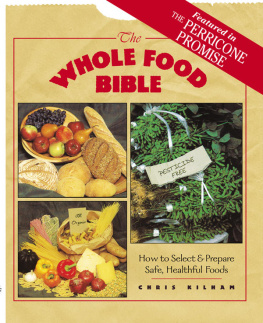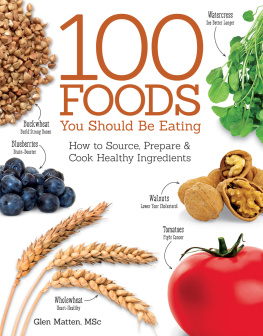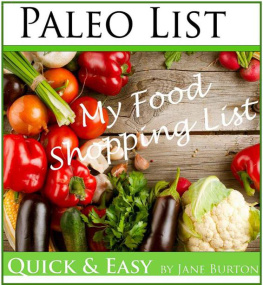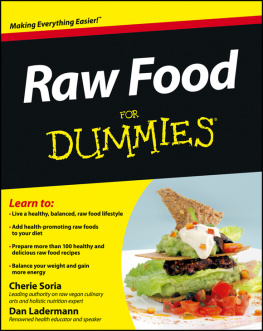The
WHOLE FOOD BIBLE
How to Select & Prepare Safe, Healthful Foods

CHRIS KILHAM
Recipes compiled and edited by Catherine Conniff
Recipe development by Catherine Conniff, Rachel Reid, and Johna Albi

Healing Arts Pres
Rochester, Vermont
To Wolf Dog Medicine Woman,
my native queen
ACKNOWLEDGMENTS
This work has required an enormous commitment of time, energy, and concentration, and would not have been possible without the generous support of many individuals. Special thanks go to my mother, Elizabeth Kilham, for unflagging support and encouragement; to Martha Moutray, editor extraordinaire; to Anna Chapman, Mary Elder Jacobsen, and Rowan Jacobsen for their valuable contributions; to Cate Conniff for her culinary flair; and to Craig Weatherby, who is just plain gold. Thank you all.
CONTENTS
Part 1

WHOLE FOOD BIBLE
WHATS HAPPENED TO FOOD?

I t used to be that all food was whole food, retaining its natural nutritional value without chemical additives of any kind. For millions of years, food was natural and nutritious; however, in the last century food has changed so radically that much of it is almost unrecognizable as food at all. Today our food is grown with the use of carcinogenic agricultural chemicals. Much of the nutritional value of food is processed out of it by high-tech methods. Chemical additives, including artificial colors, flavors, and preservatives, adulterate most of the foods on grocery store shelves. Many of these chemical agents are known or suspected carcinogens. As a result, unhealthy dietary intake is pandemic, causing dozens of serious health disorders, from cardiovascular disease to colon cancer. Whats happened to food?
The answer to this question has to do with the growth and development of modern culture. As humans have evolved, we have developed a great capacity to invent. Through invention we have changed our relationship to food and the way in which it is obtained. Hunter-gatherers in the Paleolithic period ate roots, berries, and shrubs; they trapped fish and game for food. In this earliest and longest period of human development, there was no other way to survive. Humans spent much of their lives searching for edible plants and hunting game.
In the Mesolithic and Neolithic periods, humans made a gradual transition from food gathering to food production. Early cultures learned to cultivate land and livestock, causing them to produce more abundantly. They learned to plant seeds and to raise large groups of animals. Agriculture developed and flourished, and the course of human history was altered forever. For the first time, people could produce a steady supply of food. Agricultural inventions, including the hoe, scythe, and plow, opened the door to serious, large-scale food production, enabling farmers to grow a surplus of food to trade as a commodity. Food commerce sprang up in all developing cultures as people began to trade surpluses of food crops for other valuable items, including clothing, tools, household comforts, and eventually money. Ingenious methods of transportation, storage, and product manufacturing arose as larger quantities of food entered the marketplace. Caravans of camels crossed great plains bearing loads of grains, beans, and spices. Vessels of all kinds, from crockery pots to wooden barrels, were produced to store food crops. Breads were baked, seeds were crushed for oil, and other food products were made. The primitive beginnings of food retail developed, enabling people to purchase food without turning the soil or raising animals.
The advancement of food production methods is the seed from which modern society has grown. Freedom from the labor of food production has afforded thousands of other lifestyle opportunities and has enabled people to pursue previously unexplored arts and sciences. Culture has flourished as our methods of food production have advanced. Advances in technology through continuous invention have changed society and changed our relationship to the environment. From shovels to tractors, from wood-burning hearths to gas-fired furnaces, we have created tools and processes that make our lives easier in a multitude of ways, but at the same time these devices distance us from an intimate relationship with the natural environment.
A Tainted Food Supply
Our many inventions and cultural developments have altered the face of the planet on which we live, and not always for the better. Refrigeration and improved methods of sanitation and hygiene have aided us greatly in keeping food fresh and wholesome. Meanwhile, advances in other areas of food technology have had devastating effects. In our pursuit of more, bigger, better, and faster food, we have ruined our environment and seriously jeopardized our food supply. Chemical-based, energy-intensive, high-tech food production methods have polluted our soil, water, and air; have lowered the quality of the food we eat; and have imperiled our health. The four primary factors that have contributed to the deterioration of our food and the environment in which it is produced are chemical agriculture, drugs in livestock, food processing, and chemical food additives.
Chemical agriculture became more widely practiced after World War II, when the post-war chemical industry decided that food production was an excellent field in which to earn peace-time dollars. Agricultural chemicals, including fertilizers and pesticides, were created to increase the fertility of the soil and reduce destruction of crops by insects, rodents, fungi, and other pests. Today, farmers in the United States spend more than $8 billion annually on fertilizers and apply some 2.6 billion pounds of pesticides to crops. The heavy use of toxic agrichemicals has destroyed the critically important microbial life in the soil. As a result, much of the topsoil in the United States now under cultivation is brittle and dusty and is blowing away at an alarming rate. Many agronomists say that we are headed for another dust bowl in several of the major agricultural states. The soil, water, and air in agricultural areas are heavily polluted with chemical residues that kill wildlife. Cancer rates among farm workers are inordinately high because of exposure to carcinogenic agricultural chemicals. Meanwhile, pesticide residues in food crops increase the probable risk of cancer and other serious degenerative disorders among the general public.
Ironically, our chemical-saturated farmland is no more productive than if it were cultivated organically, without the use of agrichemicals. In 1989 the National Academy of Sciences released a report on a five-year study that analyzed farming methods. The report, entitled Alternative Agriculture, stated that farmers who apply little or no chemicals to their crops achieve as high a production level as those who use synthetic fertilizers and pesticides. Pest damage is not controlled any better with pesticides than by natural, sustainable methods. The academy recommended that government farm programs turn their attention from chemical-dependent production toward promotion of natural farming techniques. Clearly, chemical agriculture is a failed system of production.
Next page












